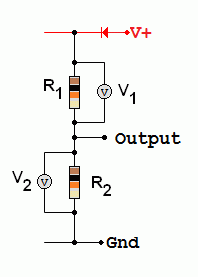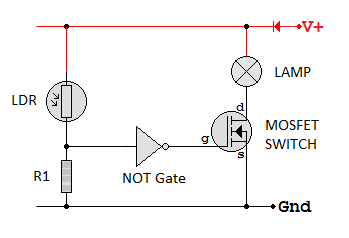
WANTED: Individual or team to take over this project. I'm in my 70's and want to put my feet up. Contact details in footer.
| GCSE Resistors BS1852 Colour Codes E24 LDR Parallel PIVR Calculations Potentiometer Puzzles Series Thermistor Timing Types >Voltage Divider< |
Resistors Voltage Divider |
|
This circuit divides the voltage in the same ratio as the resistors so V1 / V2 = R1 / R2 and V2 = Vs R2 / (R1 + R2) where Vs is the supply voltage.


R1 and R2 form a Voltage Divider. Usually one of these is variable and used to sense light, temperature, position, pressure etc.
The light sensing circuit turns on the lamp when it gets dark. A Schmitt trigger NOT gate should be used.
The voltage is divided in the ratio of the resistor values (assuming the current is the same in both resistors).
Two or more resistors in series can be used to set a required voltage at a point in a circuit. For example, this could correspond to
V2 = Vs R2 / (R1 + R2) where Vs is the supply voltage.
V1 = Vs R1/ (R1 + R2) where Vs is the supply voltage.
V1 / R1 = V2 / R2 or V1 / V2 = R1 / R2 also V1 + V2 = Vs
In this simulation, the resistors add up to 12kΩ and the voltage is 12 Volts.
This makes the maths stupidly simple.
Each "k" of resistance has one volt across it. Simples!
Click the switch to turn on the circuit.
Subject Name Level Topic Name Question Heading First Name Last Name Class ID User ID
|
Q: qNum of last_q Q ID: Question ID Score: num correct/num attempts Date Done
|
Question Text
image url
Help Link
Add Delete Clone Edit Hardness
Contact, Copyright, Cookies and Legalities: C Neil Bauers - reviseOmatic V4 - © 2016 to 2025
Hosted at Akamai Cloud - London
Please report website problems to Neil